TITLE:
AUTHOR: Bernie
DATE: 12:55 PM
STATUS: Publish
-----
BODY:
Traveling by mule wagon across the Great Plains, under what used to be a 1000-foot deep sea, it's hard to imagine what the vanished marine inhabitants looked like. Still, given what I have on hand, one mule and some photos of a mosasaur skull, I'll try. Today, we'll look at the mosasaur's head, in particuler, the structure of its mouth.
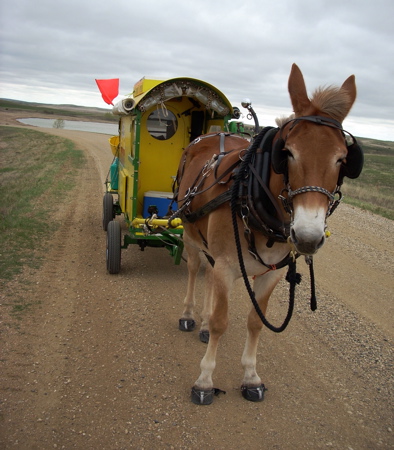
Polly on the Lost Sea seabed
Lake Alma, Saskatchewan, Canada
To review, the mosasaur was a marine lizard that swam in the Lost Sea 80 million years ago. Its closest living relatives are snakes and the monitor lizard.
Today, we'll talk about its jaws and mouth. Polly, who just happens to be standing idly by, will be pressed into service.
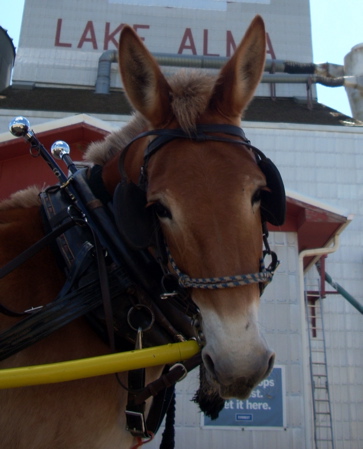
Polly - today's Mouth Model
Here's what Polly's front teeth, her incisors, look like.
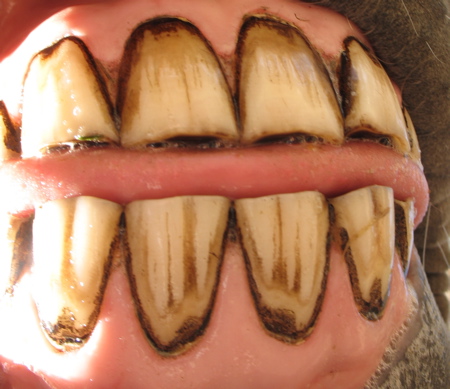
Polly's incisors
A typical herbivore, she sports 12 incisors in the front of her mouth - 6 upper and 6 lower. These flat teeth are designed for tearing grass (and the occasional book-signing cookie).
Okay, now let's look deeper into Polly's mouth. For this, I'll cram my camera into those teeth for a photo. Here's what the inside of Polly's mouth looks like.
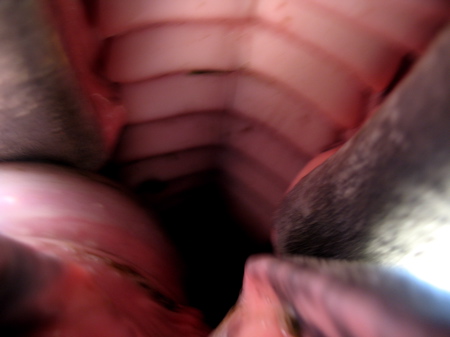
Behind Polly's incisors
What's striking is how the roof of Polly's mouth is corrugated. See those triangular, ridge-shaped rows of tissue in the roof of Polly's mouth? As Polly chews grass, she presses the bits of food against these ridges with her tongue. They're sort of like one-way speed bumps, allowing bits of food to pass toward her throat - but not back out.
Pretty cool, eh?
But what does this have to do with a mosasaur's mouth?
Quite a lot, actually. Like Polly, the mosasaur's mouth was designed to grab stuff, then work it down its throat. Here's a photo of a mosasaur fossil's maw.
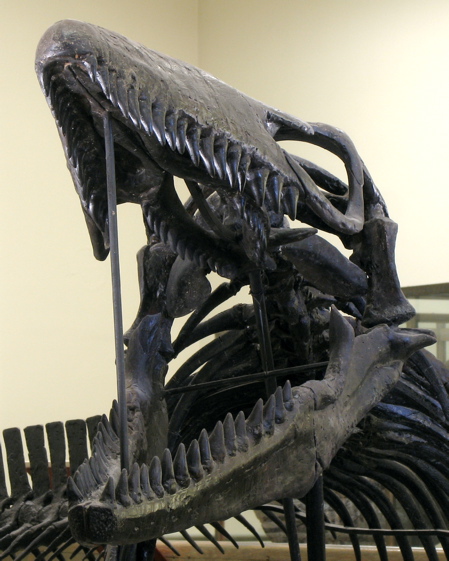
Mosasaur
Most notable are the shape of the teeth. Slender and conical, they were designed for grabbing and holding, not shredding, prey.
Okay, so a mosasuar has clamped down on a 4-foot fish. What next?
That's where the pterygoids come in.
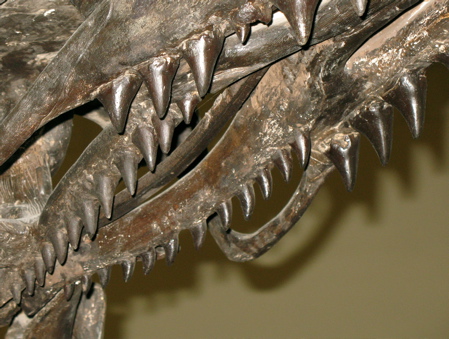
Ptergygoids (center)
Ptergygoids are special teeth found in the roof of the mosasaur's mouth, way in the back. Like the ridges in the roof of Polly's mouth, they helped hold food in place in it's inevitable journey toward the gullet.
Something the mosasuar had that Polly's doesn't is a double-jointed jaw. If you look closely at this next photo, you'll see a second joint in the jaw. It appears as a fine tan line in the lower jawbone, right behind the last teeth.
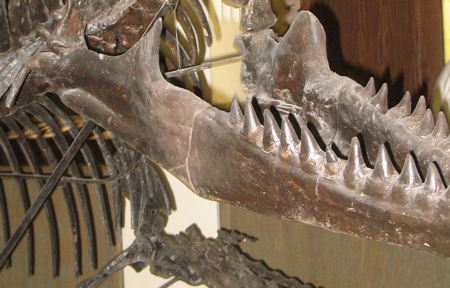
Second jaw joint (center)
This, along with a floating lower-jaw joint, allowed the jaw to swing open to almost 180 degrees. This allowed it to ratchet over-sized prey down its throat like a modern snake.
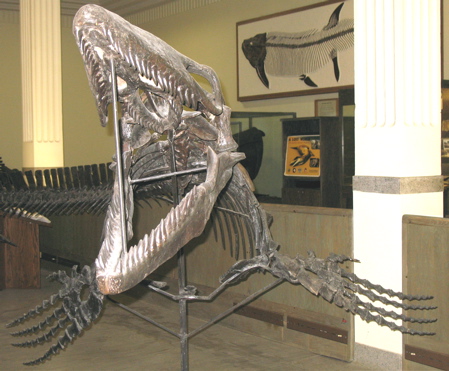
The complete mosasaur package
Pretty neat, eh?
So that's the last things fish and grass blades see here on the Lost Sea.
Coming next, how you can get your hands on a piece of Lost Sea mosasaur lore.
(Thanks to the South Dakota School of Mines and Technology for letting us photograph their mosasaur. Bernie)
--------
TITLE:
AUTHOR: Bernie
DATE: 6:20 PM
STATUS: Publish
-----
BODY:
The nation may be suffering from an early September heat wave, but just to throw a meteorological wrench into the equation, Ma Nature dusted the South Dakota Black Hills with snow. Then she threw in a tomato-killing frost.

Tomato-killer
Hard-pressed to believe that fall was so close at hand, I trudged into Hill City for a glimpse at the thermometer. Sure enough, the time-and-temperature display that had flashed 110 degrees only a month earlier now pulsed a way-lower number. At 7:01AM it displayed 26 degrees.
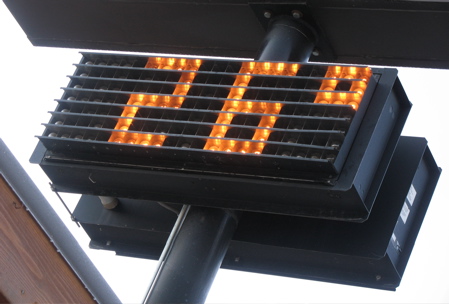
26 degrees.
Fall is on the way.
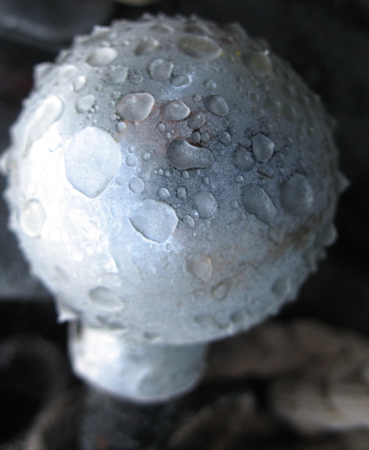
Ice on the hame balls (the hames are the metal bars that clamp around Polly's leather pulling collar)
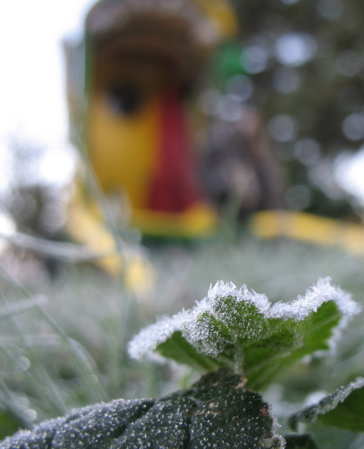
Frost and Lost Sea wagon
If you're sick and tired of the summer heat, I hope you're cooler now. Enjoy what remains of your summer.
--------
TITLE:
AUTHOR: Bernie
DATE: 11:30 AM
STATUS: Publish
-----
BODY:
Out here on the Lost Sea, the long-extinct marine life resurfaces in unusual places.
On September 10, 1804, while Lewis and Clark where exploring the Louisiana Purchase, the party came across an enormous skeleton lying on the south side of the Missouri River in Gregory County, South Dakota. Clark noted in his journal, "below the island on the top of a ridge we found a back bone with the most of the entire (length) laying Connected for 45 feet. (T)hose bones are petrified, some teeth & ribs also connected."
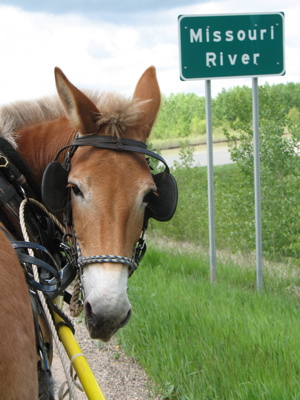
Missouri River upstream from Lewis and Clark's skeletal find
West of Fort Buford, ND
Fast forward 200 years.
On September 1, 2007, while mule Polly was pulling the Lost Sea wagon from Battle Axe Road to the Mangy Moose Bar, our party came across a three-foot jawbone outside Hill City, South Dakota. I noted in my journal, "below the Lost Sea Expedition mountain-camp, we found a crazy-big jawbone, over three-feet long - lying in a baby bed. Some teeth connected."
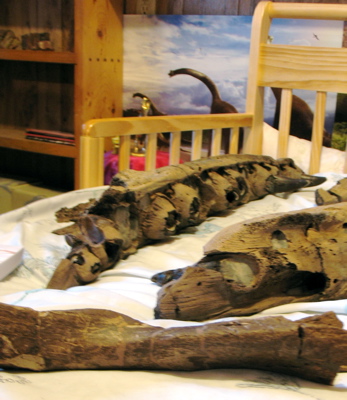
Jaw bone in a baby bed
Feeling puffed-up as Clark about my find, Polly and I proceeded to the Mangy Moose for a drink. (Clark doesn't note how his party toasted their Missouri River find but I'd wager it was stronger than the orange juice I enjoyed at the Mangy).
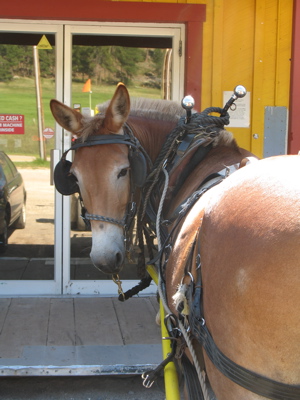
Sorry Polly: the Mangy Moose doesn't serve mules
Over my dose of vitamin C (scurvy's an imagined threat on the Lost Sea yet has driven many a Lost Sea explorer into a bar, where, often as not, he forgots about the fantasized loss of his teeth and switches to beer) I pondered the fossils.
So what Lost Sea fossil did Lewis, Clark and Harberts come across?
In Lewis and Clark's case, it's an educated guess. Part of the bones they found in that Missouri riverbank were collected and sent to Washington, DC. There, like many political dinosaurs, they vanished.
Still, based on the detailed description, most paleontologist agree they'd come across a large mosasaur, the same beast that had wielded the jaws I'd found in that baby bed.
A few days later, Jared Hudson, a Black Hills fossil hunter who owns a cast of a mosasaur jaw, shed some light on this toothy critter.
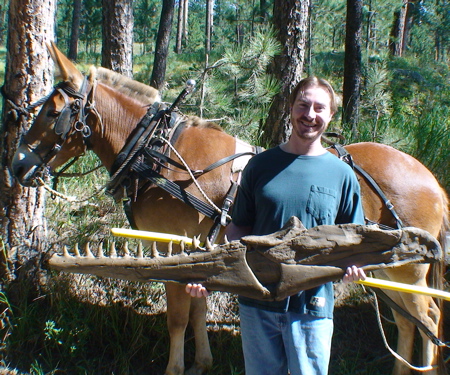
Jared's mosasaur jaw
First, the mosasaur was a big, make that huge, reptile related to today's monitor lizard. No, it wasn't a dinosaur. Though complete mosasaur skeletons are rare, it's possible, based on jaw length, to extrapolate their length.
Jared leaned his mosasaur jaw against Polly's shoulder. Polly stands 57 inches at the shoulder and the toothy mandible projected 4 inches above her shoulder. From jaw tip to jaw joint, the jawbone measured over 5 feet long.
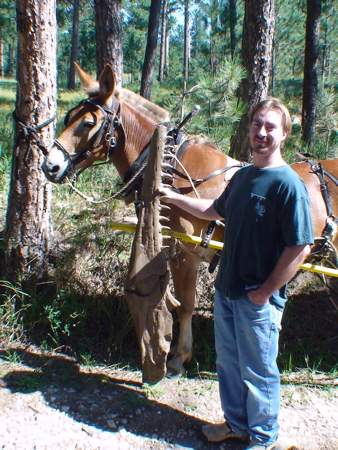
Polly wonders...
So how long would that have made the mosasaur?
"As a rule of thumb," Jared explained, "The jaw measured 10 to 15 percent of a mosasaur's length. So this one would have been around 50 feet long."
50 feet.
That's 4 times as long as the Lost Sea wagon. Or, to look at it another way, almost exactly as long as the specimen that Clark described 200 years ago.
Okay, so Lewis & Clark found their found their fossil in a riverbank and I found mine in a baby bed. The difference between then and now? Baby beds have shown up in South Dakota - and we now know a heck of a lot more about the mosasaur then Lewis & Clark did. It's not, as a member of Clark's expedition described it in Moby Dick terms, just "a monstrous large Fish".
Coming next. The life and times of the mosasaur - and how you can own a piece of mosasaur lore.
--------
















